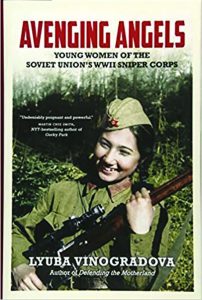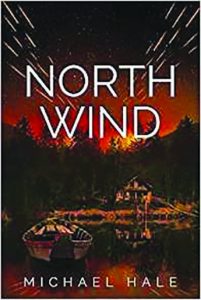WW II Soviet women snipers’ lives revealed in first-person narratives
Review by Larry S. Sterett | Contributing Editor
 AVENGING ANGELS, by Lyuba Vinogradova. Translated from the Russian by Arch Tait. ©2017. Published by MacLehose Press. Distributed in the US By Hachette Book Group, 1290 Avenue of the Americas, Dept. TGM, New York, NY 101004. Price: $26.99, plus shipping. It may be available from Amazon and other bookstores.
AVENGING ANGELS, by Lyuba Vinogradova. Translated from the Russian by Arch Tait. ©2017. Published by MacLehose Press. Distributed in the US By Hachette Book Group, 1290 Avenue of the Americas, Dept. TGM, New York, NY 101004. Price: $26.99, plus shipping. It may be available from Amazon and other bookstores.
This 304-page hardbound volume is one of the few available on the subject of the role women played in World War II combat, particularly in Russia. Usually the role was that of a nurse or some similar occupation, but not in actual combat, unless it was as a partisan or guerrilla as in Eastern Europe, the Philippines, etc. The US had female pilots ferrying planes, and we lost a few, just as we did some ammunition plant workers, etc. Only a few American women were placed in positions which could expose them to the rigors of combat. The Russians had the night witches; women who piloted canvas covered wooden single engine planes—often biplanes—at night over the German lines to drop one or two bombs on them as a harassing maneuver. (According to the Introduction by Anna Reid, the then Soviet Union sent more women into combat during WWII than any other nation, before or after, with a minimum of 570,000 and possibly as many as a million, female partisans and militias volunteers are included. Great Britain had over half a million women in uniform, but only 56,000 were allowed to actually fire weapons at the enemy, and that only as ack-ack girls manning mixed-sex anti-aircraft batteries against German aircraft over English soil. The Brit girls were not in front line combat, as were the Russian women.)
Preceding the twenty-three chapters in this tome are four maps, a listing of the 44 black and white photographs, an introduction and preface. There is also an epilogue, a Dramatis Personae– more than 50 of the people whose stories appear in this tome–end-notes for each chapter, a bibliography, photo credits, acknowledgments, an index, and notes on the author and the translator. The photos, all black-and-white, are located in two sections and feature a number of the female snipers. Actual sniping rifles, as such, are not featured separately, but many of the women are shown holding their rifles–bolt action M1891Mosin models chambered for the 7.62x54R cartridge and equipped with a 4X scope. Some auto-loading M1938 and M1940 rifles were scope equipped for sniping, but most Russian snipers, female and male, used the bolt action Mosin with long turned down bolt handle and the side-mounted 4X scope; it may have been an old design, but it was deadly in the right hands. (A few of the Mosin rifles were apparently fitted with top-mounted scopes.)
Imagine lying motionless in one spot for hours waiting for a target—possibly an enemy sniper waiting to eliminate you—to expose their location so you can take your shot and carefully leave. (Two shots from the same hide could be fatal.)
This is one of the few books available on the subject of female snipers, although there are a number of books on the subject of sniping or sharpshooting; this last term was used during the American Civil War, and both the Rebs and the Yanks had them, with Berdan’s Sharpshooters being the best known.
This is an interesting book on a subject which has not received much coverage. It’s worthy of space on the bookshelf of anyone—arms collectors, shooters, etc. interested in World War II history.
This reviewer recalls the fact, when he was in college, the female shooters on the smallbore rifle team were often better shots then the male members. At least they received more publicity and had their photos taken more often; maybe they were more attractive.
An engrossing adventure novel set in a post-apocalyptic world
Book Review By Joseph P. Tartaro | Executive Editor
 NORTH WIND, by Michael Hale. ©2017. Published by Viper Press, West Palm Beach, FL. Soft cover novel, 494 pages. Price $10.00.
NORTH WIND, by Michael Hale. ©2017. Published by Viper Press, West Palm Beach, FL. Soft cover novel, 494 pages. Price $10.00.
North Wind is Michael Hale’s first novel, and it may be the ultimate survival-adventure tale.
It begins when a group of four American men, including two combat experienced American Army colonels, set out on a fly-in remote fishing adventure in north central Canada. Their wives, who end up facing their own survival adventure, are on a separate boating trip through the Great Lakes and St. Lawrence River.
Almost upon arrival at the fishing camp, they run afoul of a foursome of belligerent young men, who become just one set of adversaries that will bedevil them throughout an apocalyptic thousand mile trek for survival.
And this may be the ultimate survival story of them all.
Have you ever wondered how you’d survive if a sudden apocalyptic event utterly cut you off from everyone and everything—including home and family? Well, North Wind provides a very believable answer.
A nuclear missile strike is launched against the United States across Canada from the Arctic Circle, and when the Army veterans sees the trajectory streaks across the sky, the lead character Brice Anderson attempts to send a warning via text message to his wife, Sharon. But he has little indication that it transmitted or was ever received.
Along with his best friend and fellow war vet, Chad, and their good friends William and John, the four men must traverse over 1200 miles of harsh environment by foot, boat and any other means that present itself along the way to reach their predetermined destination in Labrador.
Obstacles along the way include severe weather conditions, food, water, shelter, natural disasters spurred on by the nuclear attack, attacks from bears and moose, and, of course, the four deranged brothers straight out of Deliverance, that they encountered when they first got to the fishing camp.
The good guys do get some unexpected help from a number of Indian encampments, but the long road back to civilization through brutal winter weather and the most primitive conditions.
There’s a lot of uncertainty involved in this story. Along with their own survival under the most primitive conditions, they are dogged by worries about whether their families, engaged in a separate saga of survival, will be waiting for them or if they ever got the text message. And is there anything to return home to in the United States?
But that’s what good adventure, survival stories are supposed to offer, and this is a good one.
A candid look at education in New Jersey public schools
Book Review By Herbert W. Stupp
 ASK THE JANITOR: An Insider’s Look at Public Education in America, by John B. Muciaccia. © 2017. Published by Create Space, Inc., 135 pages, $10.
ASK THE JANITOR: An Insider’s Look at Public Education in America, by John B. Muciaccia. © 2017. Published by Create Space, Inc., 135 pages, $10.
Having worked as a teacher and then a school leader for over 30 years in urban (Hoboken) and suburban (Palisades Park) districts in New Jersey, John Muciaccia is well-positioned to give his insider’s take on what goes on in American public schools—and what goes wrong. His refreshingly candid Ask the Janitor speaks from deep experience, chronicling a host of problems, including the decline of the family and its corrosive impact on public school students and their prospects.
Though he doesn’t name names, Muciaccia offers troubling observations of how local politicians use school systems for patronage placements and hiring, regardless of candidates’ qualifications. This is hardly news to critics of the public school system, of course, but Muciaccia provides fresh confirmation. He also recounts how many of his teaching colleagues began coasting professionally, growing lazy once they had achieved the Holy Grail—lifetime teacher tenure. He illustrates how this corrosive practice has protected low-performing teachers and made their removal all but impossible. His solution: renewable tenure, awarded based on teacher performance and measurable classroom results.
Muciaccia does more than point fingers and identify problems. He also chronicles the inspiring achievements of reformist educators, principals, and other community leaders who have brought positive change to their schools and towns, often in the face of skepticism and outright opposition.
Muciaccia’s book arrives at an auspicious time. The Hoboken district where he taught has spent $200,000 in taxpayer funds to cover legal fees in an effort to block one of New Jersey’s most successful charter schools from expanding to offer seventh- and eighth-grade classes. An appellate court rejected Hoboken’s appeal, but the students are still waiting for those higher-caliber charter classes.
The book’s intriguing title comes from Muciaccia’s contention that the best way to find out what’s going on inside a public school is by talking with the janitor. Teachers and school administrators often respond to straightforward questions with technical language and gobbledygook, describing “processes” and “resources” instead of explaining what’s being achieved at the school. The janitor is likely to tell a visitor the truth, in clear English, the author maintains. That’s quite an admission from a professional educator, but it’s this no-nonsense, pro-parent outlook that characterizes Muciaccia’s career—and his new book.



